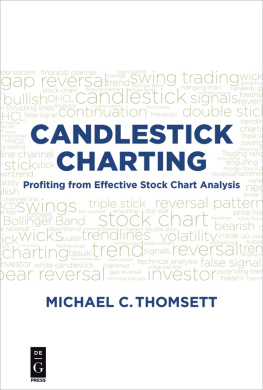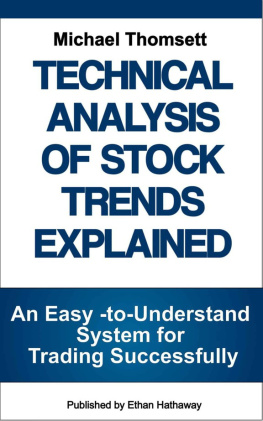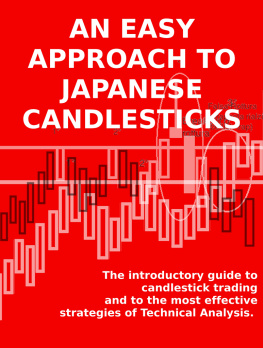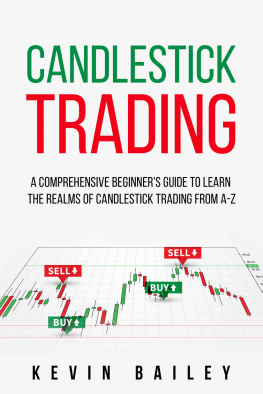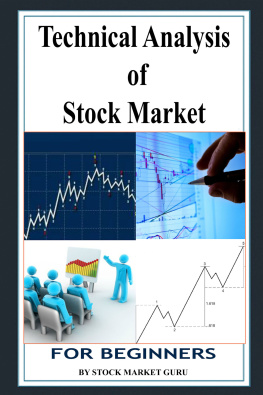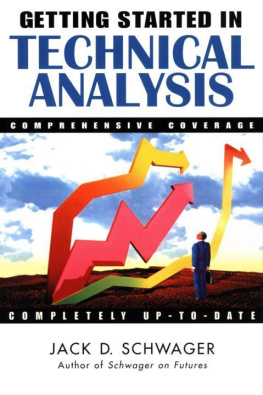Contents
Guide

Michael C. Thomsett
Candlestick Charting

ISBN 978-1-5015-1580-4
e-ISBN (PDF) 978-1-5015-0739-7
e-ISBN (EPUB) 978-1-5015-0729-8
Library of Congress Cataloging-in-Publication Data
A CIP catalog record for this book has been applied for at the Library of Congress.
Bibliographic information published by the Deutsche Nationalbibliothek
The Deutsche Nationalbibliothek lists this publication in the Deutsche Nationalbibliografie; detailed bibliographic data are available on the Internet at http://dnb.dnb.de.
2018 Michael C. Thomsett
Published by Walter de Gruyter Inc., Boston/Berlin
www.degruyter.com
Introduction
The chaotic short-term movements in stock trading create a lot of confusion and add to uncertainty among traders. A novice can observe this reality with trepidation, but even experienced professionals who have been trading for years suffer from the same affliction.
This is where chart analysis becomes valuable. No one can claim a perfect record of timing buy and sell decisions, and no one realistically expects to beat the market with every trade. It is enough to beat the averages and to out-perform the typical profit or loss experience ratio. For many, todays profits are eroded by tomorrows losses, and so many individual traders find themselves seeking trades just to get back up to dead even. The candlestick chart is a valuable tool that helps you to anticipate trends in a stocks price, and to improve the timing of buy and sell orders. Ironically, even experienced traders who refer regularly to candlestick charts often are not well versed in recognition of patterns or their significance.
Why this Book?
This book describes candlestick charts in detail and then shows how they are constructed. The advantage with this visual aid is that you can find all of the price information in one daily symbol. This includes a days opening and closing price, the trading range, and direction (upward or downward) of movement. The candlestick also shows each days breadth of trading, from high to low. When you view an array of charts over a number of trading periods, you can determine in an instant whether a stock is high- or low-volatility, trending upward or downward, and most of all, when to make a trade. Collectively, this is a valuable set of statistics. Most traders who have analyzed price movement using candlesticks understand these basic attributes of candlesticks; but if this is the extent of a traders understanding, they need more.
Beyond the basics, this book explains how to recognize different kinds of signs, moves and patterns (bull, bear, reversal, and market) and how to employ double and triple stick formations to better understand why prices behave in a particular manner. Many of these moves and patterns are subtle and their meaning is easily lost in the more recognizable patterns most traders seek.
Candlesticks are also valuable when analyzed in combination with other indicators. For example, two factors often overlooked in price-focused technical analysis are the critical attributes of price movement and risk: Volume and volatility. This book explains how candlestick chart analysis employing these important features will help you to improve your mastery of stock trading. Advanced technical analysis can be greatly enhanced by combining candlestick indicators with the better-known price patterns and trends.
The chapter on buy and sell set-up indicators examines and analyzes the use of swing trading techniques to improve the timing of trades. A set-up is a sign found in candlestick movement and breadth, pointing to the best timing of either a buy or sell; and also serving as a confirmation tool. Adding to this trend, indicators found within moving averages improve insights that are indispensable in your daily trading strategy. Moving averages show you not only where prices are today, but how these are significant in terms of what is likely to happen next. Unfortunately, the popular convergence signals often come too late to take action and maximize the timing advantage. This is where candlestick patterns can help you to anticipate trends well before other indicators solidify the information.
The dozens of technical indicators involve timing of decisions. Candlestick charts are timing tools not only for trends in upward or downward directions, but also for determining the strength or weakness of the current price movement. Some patterns are easily identified, while others reflect a lot of uncertainty among traders. The endless struggle between buyers and sellers usually involves one side or the other dominating the price movement; but at times buyers and sellers are deadlocked. This condition is just as important as a strong bull or bear pattern, because it also helps time your decision to buy, to sell, or to take no action.
After introducing the patterns of single and combined candlesticks, exploring set-up signals and moving averages, the book concludes with an analysis of candlesticks used in combination with technical indicators that most chart analysts employ. Analysis of price movement requires at least a rudimentary appreciation of a few very important price patterns, and these are most readily recognized using candlestick patterns. Whether you are an active day trader, a swing trader, or a technician, this book provides the essential visual and interpretative information you need to expand your technical knowledge. Even the conservative value investor who dabbles in speculation from time to time will find great value in the study of candlestick charts and the associated price patterns they reveal.
The book combines several important features to help you. These include special boxes with key points and definitions, checklists, examples and charts of actual companies demonstrating candlestick chart movement and their interpretation. A word about the charts of actual companies: No matter which companys charts are used or when they are picked, any chart is likely to reflect a range of prices that is out of date by the time this book is published. Most of the charts in this book are from familiar publicly traded companies, because these names are well known to most people; and that familiarity makes the analysis more accessible and practical. However, even an out of date chart is revealing. Its not the price level or current condition of a stock that matters, but the pattern and strength or weakness of price movement. The observations based on these charts apply to all stocks and at all price levels.
The charts are also consistent in their time frame. They are mostly three-month summaries of price movement with each candlestick representing a single trading day. This format was selected because a majority of traders think in terms of the opening and closing price, breadth of trading, and direction on a daily basis. Stocks open and close within the easily defined trading day. But it is also important to understand that chartists use a variety of different trading periodshourly, 15-minute or five-minute charts, for example. The amazing thing about charting is that no matter what length of time you use in your chart analysis, the same rules and observations apply. A pattern is going to be found in a daily or weekly chart and likewise in a one-minute chart. The significance of movement is identical even though the timing of trade decisions is different. So a trader, generally making decisions from day to day, is going to act in the context of daily change. A day trader, in comparison, is likely to use the shorter-term charts and make decisions in terms of hours or even minutes. Both are using the same trading information, moving averages, and patterns; that is a fact worth remembering.

